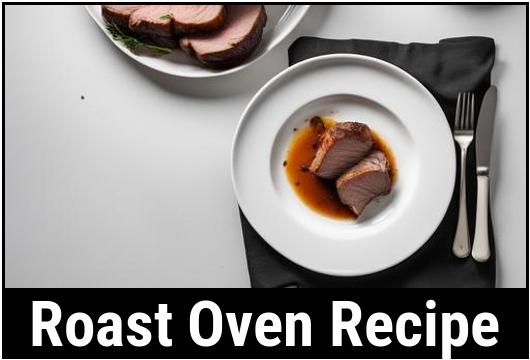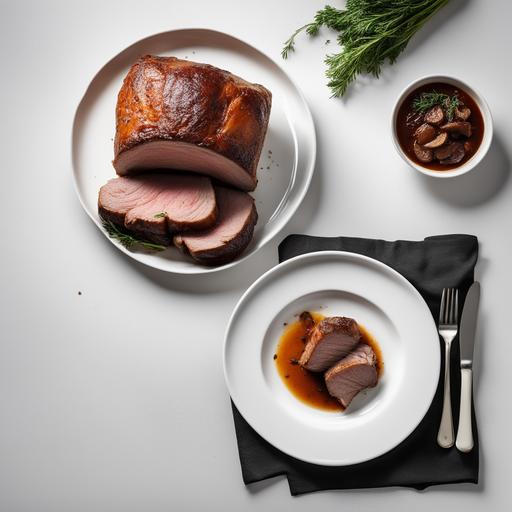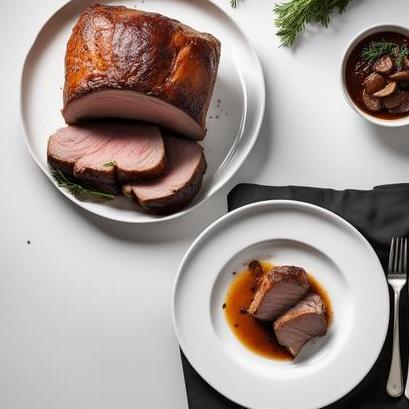- You are here:
- Home »
- Oven Recipes
- » The Art Of Roasting Meat In The Oven

The Art Of Roasting Meat In The Oven
Cooking a perfectly tender and juicy roast in the oven is truly an art form. The process of roasting requires careful attention to detail, from selecting the right cut of meat to properly seasoning and preparing it for cooking. With the right technique, anyone can become a master of the roast oven recipe.
The Science of Roasting
Understanding the science behind roasting is essential to achieving the perfect outcome. Roasting is a dry heat cooking method that involves cooking meat in an oven at high temperature. The heat denatures proteins in the meat, causing them to coagulate and form a crust on the surface of the meat. The high temperature also causes the meat to undergo the Maillard reaction, which creates the delicious browned crust that is so desired.
Selecting the Right Cut of Meat
Choosing the right cut of meat is a crucial step in roasting. The best cuts of meat for roasting are those that have a good amount of fat and connective tissue, such as beef tenderloin, pork loin, and chicken thighs. The fat and connective tissue melt during cooking, basting the meat and keeping it juicy and tender.
Cleaning and Preparing the Meat

Before roasting, it is important to properly clean and prepare the meat. Start by rinsing the meat under cold water and patting it dry with paper towels. Trim any excess fat and remove any silver skin or connective tissue.
Next, season the meat with your choice of spices, herbs, and aromatics. Some popular options include garlic, rosemary, thyme, salt, and pepper. You can also add a rub or marinade to enhance the flavor.
Tips for Roasting Meat in the Oven
To ensure a perfectly cooked roast, follow these tips:
-
Use a meat thermometer to check the internal temperature of the meat. For beef, aim for a temperature of 135°F for medium-rare, 145°F for medium, and 160°F for well-done. For pork and chicken, aim for an internal temperature of 165°F.
-
Let the meat rest for 10-15 minutes after cooking. This allows the juices to redistribute, resulting in a moist and tender roast.
-
Baste the meat with pan drippings or a mixture of butter and herbs during cooking. This will help keep the meat moist and add flavor.
-
Use a roasting rack to elevate the meat and allow air to circulate around it. This will help the meat cook more evenly and prevent it from sticking to the pan.
Variations of Roast Oven Recipe
While beef, pork, and chicken are popular choices for roasting, there are many other options as well. Lamb, turkey, and even game meats like venison and elk can be roasted to perfection in the oven. You can also experiment with different spices and marinades to create unique flavor profiles.
Checking for Doneness

Checking for doneness is crucial to ensuring that your roast is cooked to perfection. Use a meat thermometer to check the internal temperature of the meat, and be sure to check in multiple places to ensure accuracy. If you don’t have a meat thermometer, you can also check for doneness by pressing on the meat with your finger. A rare steak will feel soft and squishy, while a well-done steak will feel firm and springy.
Recipe
Here is a simple and delicious recipe for roast beef in the oven:
Ingredients:
-
3 lb beef tenderloin
-
3 cloves garlic, minced
-
1 tbsp fresh rosemary, chopped
-
1 tbsp fresh thyme, chopped
-
1 tbsp kosher salt
-
1 tsp black pepper
-
2 tbsp olive oil
-
1 cup beef broth
Instructions:
-
Preheat the oven to 450°F.
-
In a small bowl, mix the garlic, rosemary, thyme, salt, pepper, and olive oil to make a seasoning paste.
-
Rub the seasoning paste all over the beef tenderloin.
-
Place the tenderloin on a roasting rack in a roasting pan.
-
Pour the beef broth into the bottom of the roasting pan.
-
Roast the tenderloin for 15 minutes at 450°F, then reduce the temperature to 325°F and continue to roast for another 45-60 minutes, or until the internal temperature reaches 135°F for medium-rare.
-
Let the tenderloin rest for 10-15 minutes before slicing.
Overcook and Undercook
Overcooking or undercooking your roast can result in a dry, tough, or chewy texture. To avoid overcooking, use a meat thermometer to check the internal temperature of the meat regularly. To avoid undercooking, make sure that the oven temperature is set correctly and that the meat has enough time to cook fully.
Conclusion
Roasting meat in the oven is a classic cooking technique that every home cook should master. With the right tools and technique, anyone can create a delicious, tender, and juicy roast that will leave their guests begging for seconds. Follow the tips and recipe provided in this guide to become a roast oven recipe expert. Happy cooking!
Sources
FAQS On Roast Oven Recipe
What Is A Roast Oven Recipe?
A roast oven recipe is a cooking method that involves placing meat or vegetables in a hot oven to slowly cook and develop flavors. This method typically results in tender and succulent roasted dishes, making it a popular choice for cooking large cuts of meat such as beef roasts or whole chickens.
How Do I Choose The Right Cut Of Meat For A Roast Oven Recipe?
When selecting meat for a roast oven recipe, it is important to choose cuts that are suitable for slow cooking. Look for well-marbled cuts with a good amount of fat, as this will help keep the meat moist and flavorful during the long cooking process. Some popular choices include chuck roast, sirloin tip roast, or a whole chicken.
What Temperature And Cooking Time Should I Use For A Roast Oven Recipe?
The temperature and cooking time for a roast oven recipe will vary depending on the specific cut of meat and the desired level of doneness. However, a general guideline is to preheat the oven to 325°F (163°C) and allow approximately 20 minutes of cooking time per pound of meat. It is advisable to use a meat thermometer to ensure the internal temperature reaches the desired doneness, such as 145°F (63°C) for medium-rare beef.
Are There Any Recommended Seasonings Or Marinades For A Roast Oven Recipe?
Seasonings and marinades can greatly enhance the flavor of a roast oven recipe. Common seasonings include salt, pepper, garlic powder, and herbs such as rosemary or thyme. You might also consider using a marinade to infuse additional flavors into the meat. Popular marinades can include a mixture of soy sauce, Worcestershire sauce, garlic, and olive oil. It is best to marinate the meat for at least a few hours, or even overnight, before roasting.
What Are Some Tips For Achieving A Perfectly Roasted Dish With A Roast Oven Recipe?
To ensure a successful roast oven recipe, there are a few handy tips to keep in mind. First, make sure the meat is at room temperature before placing it in the oven. This allows for more even cooking. Additionally, using a roasting rack will help elevate the meat, allowing heat to circulate around it and promote even browning. Tenting the meat with foil during part of the cooking process can help retain moisture. Finally, after removing the roast from the oven, allow it to rest for about 10-15 minutes before slicing. This gives the juices time to redistribute throughout the meat, resulting in a moist and tender final dish.



